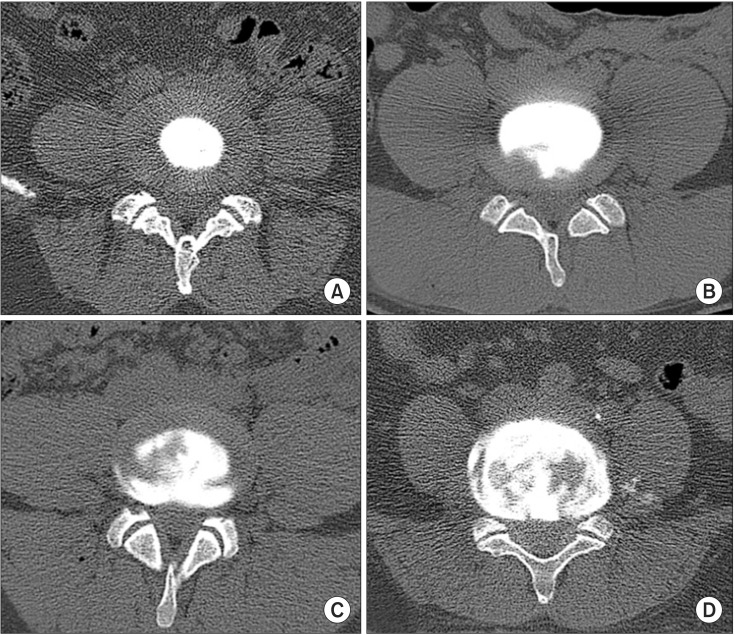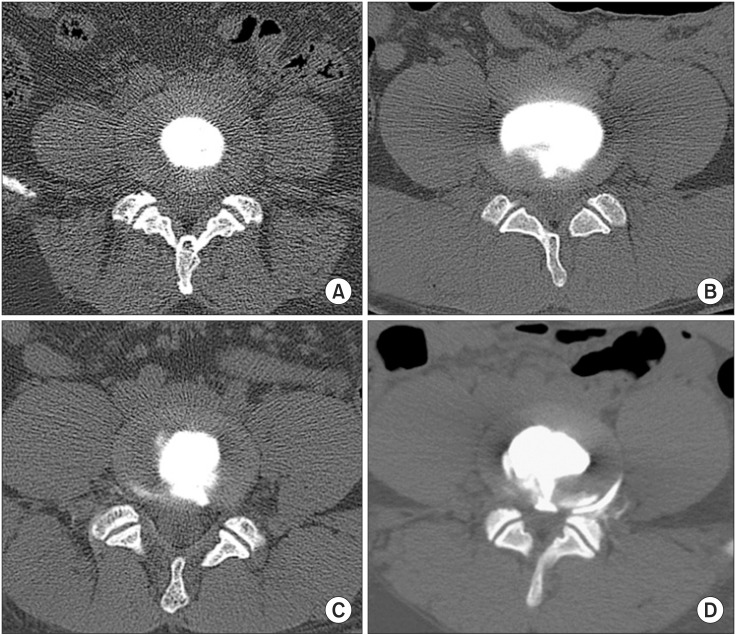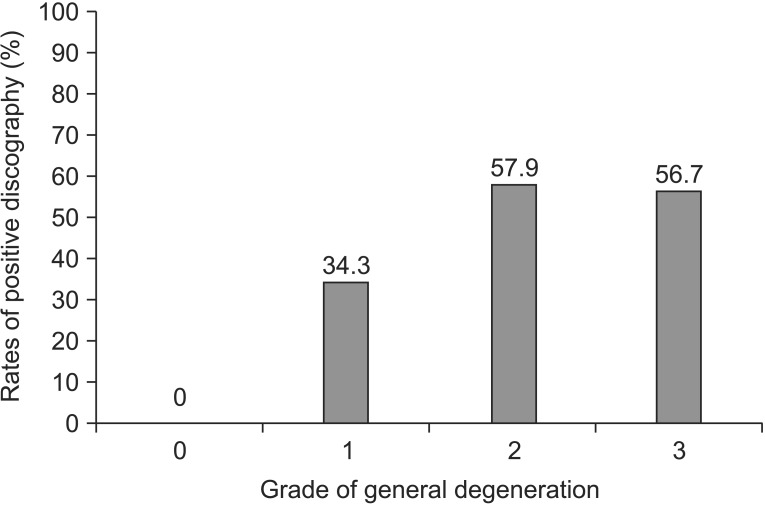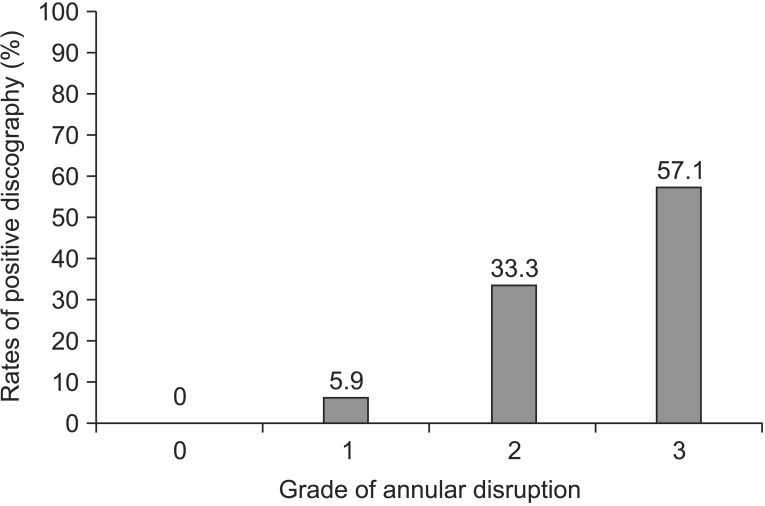Ann Rehabil Med.
2015 Jun;39(3):340-346. 10.5535/arm.2015.39.3.340.
Analysis of the Correlation Among Age, Disc Morphology, Positive Discography and Prognosis in Patients With Chronic Low Back Pain
- Affiliations
-
- 1Department of Physical Medicine & Rehabilitation, Korea University School of Medicine, Seoul, Korea. spinelee@gmail.com
- KMID: 2165636
- DOI: http://doi.org/10.5535/arm.2015.39.3.340
Abstract
OBJECTIVE
To investigate the correlation among age, disc morphology, positive discography, and prognosis in patients with chronic low back pain.
METHODS
A total of 183 intervertebral discs in 72 patients with chronic low back pain were studied. Discography was performed using a pressure-controlled manometric technique. The pain reaction during discography at each level was recorded as follows: no pain, dissimilar pain, similar pain, or concordant pain. Discs with similar or concordant pain were classified as positive. All the examined discs were assessed morphologically using axial computed tomography imaging. The grade of general degeneration and annular disruption of the discs were assessed according to the Dallas discogram description (DDD). Intradiscal injection of steroid was tried for patients with symptomatic disc identified during provocative discography and who did not consent to surgical operation.
RESULTS
There was a higher correlation between general degeneration and age, as compared with annular disruption and age. Higher general degeneration and annular disruption grades had higher positive rates of discography. However, annular disruption alone was independently associated with positive discography. Age and grade of general degeneration did not affect the prognosis.
CONCLUSION
The grade of general degeneration was associated with age, but it was not correlated with positive discography and prognosis. In addition, high grade of annular disruption correlated with positive discography.
MeSH Terms
Figure
Reference
-
1. Andersson GB. Epidemiological features of chronic low-back pain. Lancet. 1999; 354:581–585. PMID: 10470716.
Article2. Kuslich SD, Ulstrom CL, Michael CJ. The tissue origin of low back pain and sciatica: a report of pain response to tissue stimulation during operations on the lumbar spine using local anesthesia. Orthop Clin North Am. 1991; 22:181–187. PMID: 1826546.3. Manchikanti L, Singh V, Pampati V, Damron KS, Barnhill RC, Beyer C, et al. Evaluation of the relative contributions of various structures in chronic low back pain. Pain Physician. 2001; 4:308–316. PMID: 16902676.4. Schwarzer AC, Aprill CN, Derby R, Fortin J, Kine G, Bogduk N. The relative contributions of the disc and zygapophyseal joint in chronic low back pain. Spine (Phila Pa 1976). 1994; 19:801–806. PMID: 8202798.
Article5. Hancock MJ, Maher CG, Latimer J, Spindler MF, McAuley JH, Laslett M, et al. Systematic review of tests to identify the disc, SIJ or facet joint as the source of low back pain. Eur Spine J. 2007; 16:1539–1550. PMID: 17566796.
Article6. Kang CH, Kim YH, Lee SH, Derby R, Kim JH, Chung KB, et al. Can magnetic resonance imaging accurately predict concordant pain provocation during provocative disc injection? Skeletal Radiol. 2009; 38:877–885. PMID: 19430778.
Article7. Horton WC, Daftari TK. Which disc as visualized by magnetic resonance imaging is actually a source of pain? A correlation between magnetic resonance imaging and discography. Spine (Phila Pa 1976). 1992; 17(6 Suppl):S164–S171. PMID: 1385901.8. Zucherman J, Derby R, Hsu K, Picetti G, Kaiser J, Schofferman J, et al. Normal magnetic resonance imaging with abnormal discography. Spine (Phila Pa 1976). 1988; 13:1355–1359. PMID: 2975063.
Article9. Manchikanti L, Glaser SE, Wolfer L, Derby R, Cohen SP. Systematic review of lumbar discography as a diagnostic test for chronic low back pain. Pain Physician. 2009; 12:541–559. PMID: 19461822.10. Wolfer LR, Derby R, Lee JE, Lee SH. Systematic review of lumbar provocation discography in asymptomatic subjects with a meta-analysis of false-positive rates. Pain Physician. 2008; 11:513–538. PMID: 18690280.11. Adams MA, Dolan P, Hutton WC. The stages of disc degeneration as revealed by discograms. J Bone Joint Surg Br. 1986; 68:36–41. PMID: 3941139.
Article12. Sachs BL, Vanharanta H, Spivey MA, Guyer RD, Videman T, Rashbaum RF, et al. Dallas discogram description: a new classification of CT/discography in low-back disorders. Spine (Phila Pa 1976). 1987; 12:287–294. PMID: 2954226.
Article13. Vanharanta H, Sachs BL, Spivey MA, Guyer RD, Hochschuler SH, Rashbaum RF, et al. The relationship of pain provocation to lumbar disc deterioration as seen by CT/discography. Spine (Phila Pa 1976). 1987; 12:295–298. PMID: 3589823.
Article14. Zhang JD, Xia Q, Hu YC, Miao J, Feng QJ. Analysis of the relationship between morphology of intervertebral disc and some correlated factors following discography in patients with chronic low back pain. Orthop Surg. 2009; 1:47–51. PMID: 22009781.
Article15. Derby R, Lee SH, Lee JE, Lee SH. Comparison of pressure-controlled provocation discography using automated versus manual syringe pump manometry in patients with chronic low back pain. Pain Med. 2011; 12:18–26. PMID: 21040439.
Article16. Urban JP, Roberts S. Degeneration of the intervertebral disc. Arthritis Res Ther. 2003; 5:120–130. PMID: 12723977.17. Adams MA, Roughley PJ. What is intervertebral disc degeneration, and what causes it? Spine (Phila Pa 1976). 2006; 31:2151–2161. PMID: 16915105.
Article18. Haefeli M, Kalberer F, Saegesser D, Nerlich AG, Boos N, Paesold G. The course of macroscopic degeneration in the human lumbar intervertebral disc. Spine (Phila Pa 1976). 2006; 31:1522–1531. PMID: 16778683.
Article19. Miller JA, Schmatz C, Schultz AB. Lumbar disc degeneration: correlation with age, sex, and spine level in 600 autopsy specimens. Spine (Phila Pa 1976). 1988; 13:173–178. PMID: 3406837.20. Tertti MO, Salminen JJ, Paajanen HE, Terho PH, Kormano MJ. Low-back pain and disk degeneration in children: a case-control MR imaging study. Radiology. 1991; 180:503–507. PMID: 1829844.
Article21. Erkintalo MO, Salminen JJ, Alanen AM, Paajanen HE, Kormano MJ. Development of degenerative changes in the lumbar intervertebral disk: results of a prospective MR imaging study in adolescents with and without low-back pain. Radiology. 1995; 196:529–533. PMID: 7617872.
Article22. Feffer HL. Treatment of low-back and sciatic pain by the injection of hydrocortisone into degenerated intervertebral discs. J Bone Joint Surg Am. 1956; 38-A:585–592. PMID: 13319413.
Article23. Feffer HL. Therapeutic intradiscal hydrocortisone: a long-term study. Clin Orthop Relat Res. 1969; 67:100–104. PMID: 4243380.24. Khot A, Bowditch M, Powell J, Sharp D. The use of intradiscal steroid therapy for lumbar spinal discogenic pain: a randomized controlled trial. Spine (Phila Pa 1976). 2004; 29:833–837. PMID: 15082979.25. Cao P, Jiang L, Zhuang C, Yang Y, Zhang Z, Chen W, et al. Intradiscal injection therapy for degenerative chronic discogenic low back pain with end plate Modic changes. Spine J. 2011; 11:100–106. PMID: 20850390.
Article26. Aoki M, Kato F, Mimatsu K, Iwata H. Histologic changes in the intervertebral disc after intradiscal injections of methylprednisolone acetate in rabbits. Spine (Phila Pa 1976). 1997; 22:127–132. PMID: 9122791.
Article27. Carragee EJ, Don AS, Hurwitz EL, Cuellar JM, Carrino JA, Herzog R. 2009 ISSLS Prize Winner: does discography cause accelerated progression of degeneration changes in the lumbar disc: a ten-year matched cohort study. Spine (Phila Pa 1976). 2009; 34:2338–2345. PMID: 19755936.
- Full Text Links
- Actions
-
Cited
- CITED
-
- Close
- Share
- Similar articles
-
- Pain Provocation and Disc Degeneration in Lumbar Discography
- Discogenic Lumbar Pain: Correlation between Magnetic Resonance Imaging and Discography
- Intradiscal Electrothermotherapy(IDET) in Patients with Chronic Discogenic Low Back Pain; Preliminary Report
- Significance of CT after discography
- Diagnostic Value of Image Findings of MRI and Discography for the Internal Disc Disruption






